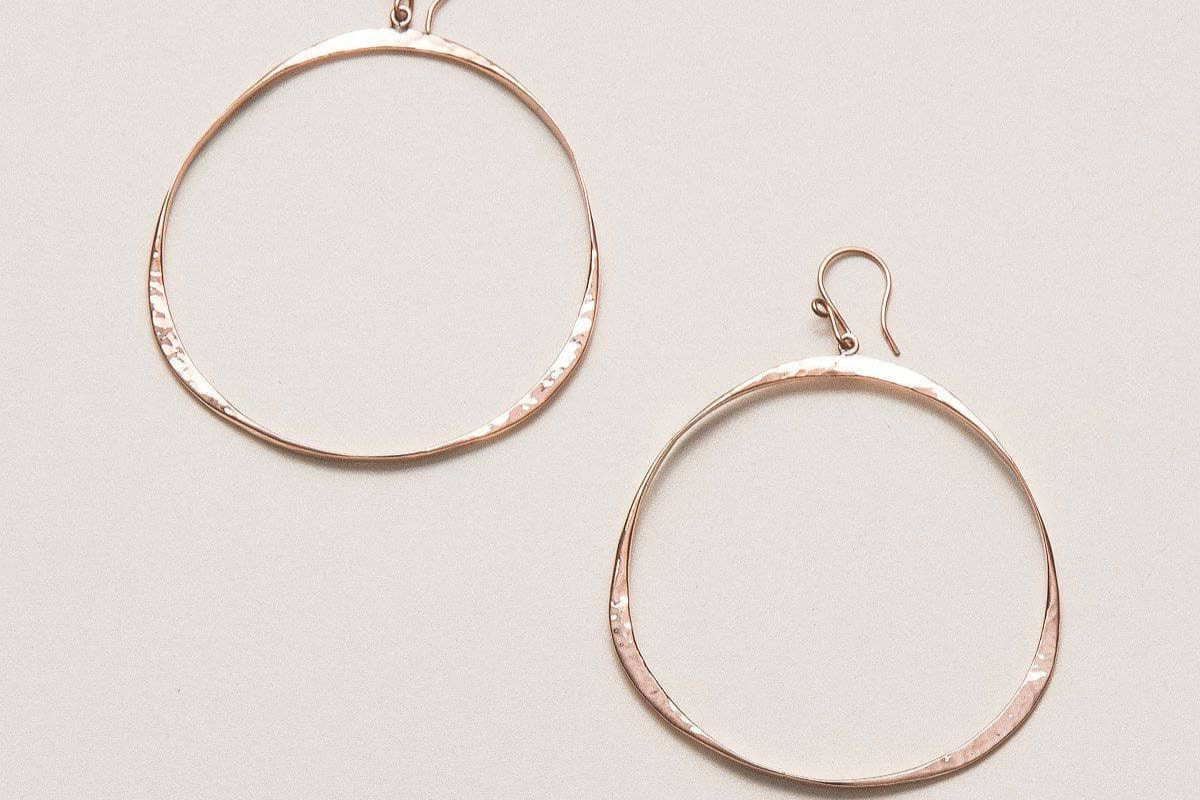
Bright and beautiful, copper is one of the prettiest metals out there. With its reddish-golden glow and warm vibes, copper jewelry had already made its mark on the world during the days of antiquity and shows no signs of slowing down. Even today, copper bracelets are revered for their health benefits, and copper women's rings, women's necklaces, and other copper pieces are also loved for their style and spiritual ethos especially when paired with healing crystal jewelry. Caring for your copper items is essential as it's a metal that can lose its luster if not looked after properly. Here, we delve into all the best ways to clean copper.
Why Clean Copper?
The Importance of Cleaning Copper
One of the most important reasons for keeping your copper clean is that it can tarnish without proper care and cleaning. If you want to keep your metal shiny and bright, then regular maintenance will help. Copper that is dull and tarnished isn't as aesthetically pleasing as clean copper. But even beyond the art of aesthetics, it's also important to clean your copper because it can also help with the longevity of your copper pieces.
Benefits of Cleaning Copper
There are many benefits that come with cleaning your copper jewelry, copper cookware, copper pans, and any other copper goods you have in your life. Here are some reasons to keep your copper clean.
A shiny finish - part of the allure of copper comes from its dazzling shine - especially in copper pieces that are decorative in nature. A clean copper detox keeps it looking beautiful and new.
Keeps corrosion at bay - copper can corrode if left to the elements (like any metal). Moisture and oxygen over time can cause tarnishing, and eventually, your copper may weaken and become more susceptible to corrosion. By keeping it clean, you reduce contaminating factors.
High conductivity - copper is famed for being an amazing conductor, which is why copper wires are often used in electrics. But even when it comes to spiritual energy and your copper jewelry, by keeping it clean, you can encourage a clear line of energy that looks beautiful against your fave bamboo clothing brands.
Say goodbye to bacteria - while one of the major benefits of copper (and why it's often used in cookware) is the fact that it is antimicrobial and antibacterial by nature, that doesn't mean it's completely immune to contaminants. Keeping your copper surfaces clean can help keep pathogens and bacteria away.
Tools and Supplies for Cleaning Copper

Soft Cloth or Sponge
Avoid using abrasive cloths or sponges on your copper items, as this could cause scratches on the surface.
Mild Soap or Detergent
Mild dish soap or a mild detergent is the best, as you want to avoid using harsh chemicals on your copper items.
Vinegar or Lemon Juice
Household staples like vinegar and lemon juice are natural ingredients that can help remove copper tarnish.
Baking Soda or Salt
Table salt, coarse salt - or baking soda are famed for taking away tarnish from pieces of copper. These work well on heavier tarnishes and when combined with vinegar or lemon.
Commercial Copper Cleaners
For those truly stubborn stains, you may want to turn to commercial copper cream cleaners.
Methods for Cleaning Copper

Method 1: Soap and Water
One of the simplest methods for cleaning grime and dirt from your copper is to turn to soap and water. A few drops of mild dish soap, some warm water, and a soft-bristled brush or a soft sponge are all you need. While this method won't remove stubborn tarnish stains, it is effective for everyday dirt. Make sure that you rinse all the soapy water away and use a dry cloth to buff and shine.
Method 2: White Vinegar and Salt
If you want a heavier-duty option for cleaning copper, you can make a mix of white vinegar and salt. Simply add one tablespoon of salt for every cup of vinegar and make a paste that can be rubbed onto your copper goods with a soft cloth. Be sure to rinse and dry afterward.
Method 3: Lemon and Salt
The lemon and salt mix is perfect for when you need to bring a little elbow grease to those nonfragile copper pieces. Copper sinks, copper pots, and the bottoms of copper cookware can all benefit from this method. Simply slice a lemon in half, add salt to the cut lemon, and rub the copper with the lemon. You can also make the lemon and salt into a paste by adding a little flour or baking soda and then use a soft brush or damp cloth to rub it on your piece. As usual, rinse properly and use microfiber cloths to buff to a shine.
Method 4: Baking Soda and Water
Use a little warm water and mix with baking soda until you have a paste. This paste can then be liberally applied to your copper items. Use a soft brush to scrub any tough, tarnished stains using a circular motion. You can also buff it back to a beautiful shine with a soft dry cloth. Baking soda is a dab hand at helping clean tarnished copper as it has naturally abrasive qualities.
Method 5: Commercial Copper Cleaners
If you are going to use strong chemicals to clean your copper, make sure that you only use commercial cleaners intended for copper items. These are specifically designed to remove tough stains and tarnishes but make sure you also pick the appropriate cleaner for your copper item. For example, you may want a gentler commercial copper cleaner for your copper jewelry. Usually, you apply the cleaning solution to a soft cloth and rub the copper with it. You may also have to let the cleanser sit on the item for a while before rinsing it thoroughly. Always follow the label when using commercial copper cleaners, as different brands can have different methods.
Method 6: Cream of Tartar
If you want to skip heavy-duty commercial cleaning products, cream of tartar can be a solid alternative. Mix the cream of tartar in a bowl with some lemon or vinegar until you get a paste - generally, one tablespoon of tartar and then enough liquid to make a paste. Use a soft cloth to rub the mix onto your item, and use a circular motion to rub it in. Wait 15 minutes before rinsing the mix away. To polish copper, use a clean microfiber cloth.
Method 7: Ketchup
So much more than a condiment - the cupboard staple of ketchup is also known to be a copper cleaner thanks to the acidic nature of the tomatoes. Apply a layer of ketchup onto your copper goods and rub it in using a cloth or soft-bristled brush. Rinse thoroughly and buff dry with a clean cloth.
Tips for Maintaining Clean Copper

Regular Cleaning Schedule
How often you should clean your copper will vary depending on whether you are talking about copper pans, copper pipes, copper surfaces, or copper jewelry. All copper will go through the process of oxidation (as it naturally reacts with oxygen), and this causes copper oxide, which affects the color and shine of your item. You can slow the tarnish caused by copper oxide by maintaining a regular cleaning schedule, as copper is a reactive metal when it comes to chemicals in the atmosphere. Every three months should help slow the tarnishing process and keep your copper shiny and bright.
Protective Coatings
Another way of keeping shiny copper happy and slowing the oxidation process is by applying a protective coating to your copper items. Even something as simple as applying clear nail polish to healing copper jewelry can offer a protective layer finish and keep it looking shiny and bright against your bamboo clothing. You can also choose items where the copper exterior has had a lacquer finish which will help your copper keep that subtle glow without tarnished spots and discoloration.
Avoid Harsh Chemicals
You want to avoid using harsh chemicals when cleaning your beautiful copper pieces. As copper is a soft metal, it needs a little extra TLC when it comes to protecting it from abrasive cleaners and acidic elements. Harsh chemicals can strip the copper of its protective coating and can encourage corrosion, tarnish, and discoloration. Natural cleaners and a gentle cloth can be the safest way to deal with copper cleaning.
Store Copper Properly
Keep your copper tucked up safe by storing it in a cool, dry place when not in use. If you can, avoid leaving copper in direct sunlight or places where it may be exposed to water. Heat and moisture can cause copper to tarnish. Avoid placing your copper items too close to other metals - such as steel or iron as they may encourage corrosion.
FAQs
What is the easiest way to clean copper?
One of the simplest and easiest ways to clean your copper is with a vinegar and salt mixture. Mix equal parts of table salt and vinegar in a bowl and use a soft cloth to rub it onto your copper item in a circular motion. Rinse thoroughly and use a dry towel to remove any moisture. If your piece is badly tarnished or burnished, you may need a heavier-duty method such as ketchup, baking soda, or cream of tartar.
What cleans copper the fastest?
For those who want one of the fastest cleaning methods for copper, you may want to look to commercial cleaners. However, commercial chemicals can have more abrasive techniques than natural cleaners, so be sure to read the label carefully. A fast all-natural method can also be baking soda and lemon juice mixed until it reaches the consistency of toothpaste - apply in circular motions and then rinse and dry.
How do you clean badly tarnished copper?
The best way to treat badly tarnished copper is to use a mixture of baking soda and lemon. The acidity of the lemon and the gentle abrasiveness of the baking soda can work together to clear tarnished stains. A heavier-duty option can also be the household staple of ketchup, as the acid in tomatoes can also remove tough tarnish stains.
How do you clean oxidation off copper?
Oxidation can form on copper when the metal reacts with oxygen and moisture in the air. To clean oxidation from copper, you can use a mixture of white vinegar and table salt. You can also use vinegar and lemon or lemon and baking soda. For heavier stains - ketchup or commercial cleaners can also work.





























































